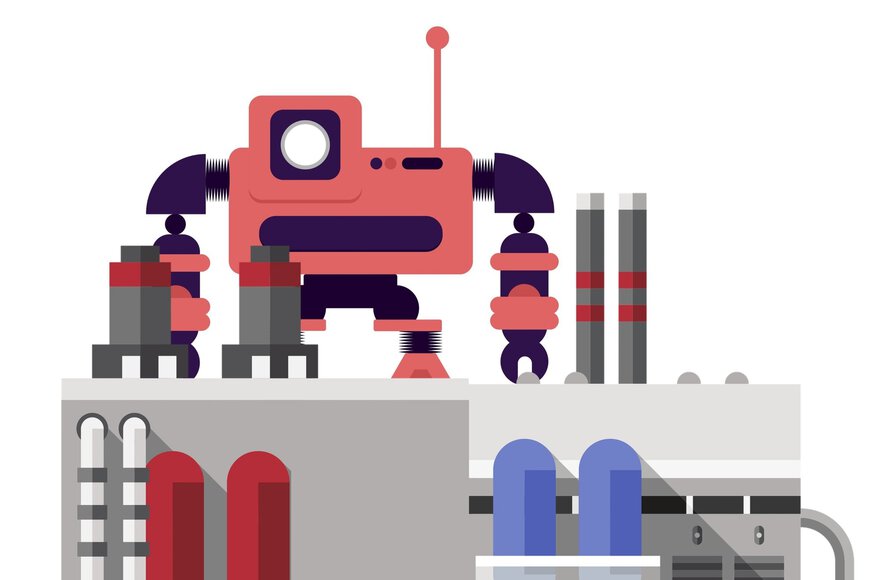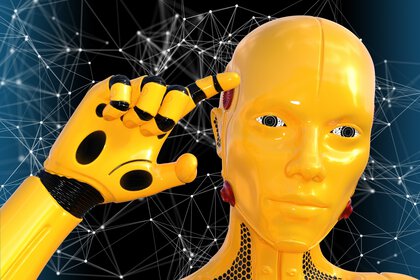The Path to Autonomous Production
A complete autonomously operating factory that reliably and without human assistance produces highly individualized products in constantly changing but small batch sizes, day and night, with high cycle times and significantly lower unit costs than before – this is the vision of autonomous production. How close is industry to this vision? What role will people play in the this?
The Difference: Autonomous vs. Automated
Autonomous production goes one step further than highly automated processes. An autonomous system should be able to identify unforeseen situations, assess them and make a meaningful decision on its own. Human intervention should not be necessary for long periods of time. As a result, autonomous production systems are able to plan and control production itself.
On the other hand, automated processes are more like a reflex. When a doctor taps your patella tendon below your kneecap with a reflex hammer, your leg bounces up. This is also the case with automated processes. They are designed using "If, then…" logic. When a sensor returns a previously defined value, a specific actuator will perform a pre-defined action. This is essentially time-biased remote control that covers a number of defined scenarios.
Who needs autonomous production and why?
Autonomous production comes into focus when the system has become so large and complex that it is impossible to anticipate and automate all relevant constellations. Logistics systems and automated production facilities as well as cyber-physical systems must be organized in a “smart factory”. This includes driverless transport systems, learning machines, sensors, cameras, drones and last but not least the IT systems that control all processes. All these units should be self-learning, situation-adaptive and comprehensively networked with one another if the process is to proceed autonomously. They work with foresight. Consequently, completely order-controlled production can be achieved.

AI and machine learning
AI is the generic term for algorithms that enable intelligent decisions. The most modern form of AI uses neural networks to develop self-learning systems for machine learning. Machine learning is the key technology of AI and originates in machine vision for quality control, where it is a matter of detecting patterns to identify deviations. Using machine learning, technical systems expand their application possibilities by developing new models autonomously.
So-called "weak AI" can only solve precisely the tasks for which it was developed and trained. “Strong AI” is similar to the human mind and consequently can provide transfer services and plan strategically. AI is used in industrial production, especially in process monitoring, process control and preventive maintenance. There are already products based on AI that are able to predict up to 95 percent of machine-related production downtime.

Machine vision and sensor data processing
In the same way as the collection and processing of all other sensor data, highly developed machine vision is a prerequisite for autonomous production. The more high-quality or annotated data, i.e., supplemented by structured additional information, are available from the production process for utilization, the more precise AI decisions can be made.
Simulations, for example for lot size 1
In contrast to series production, in which processes are monitored using previous process data, existing measured values cannot be used for batch size 1. However, if you want to monitor the first and only instance, software-controlled process simulations must determine reference values for this. This in turn requires a consistent connection between a company's high-performance IT and the manufacturing level.
Consistent networking and decentralized systems
All those involved in the process must be networked with each other, i.e., along the entire chain from incoming orders to production and delivery. At the same time, production decisions can only be made in real time if, for example, controlling a robot is possible using its own, decentralized computing capacities.
Robots and autonomous transport systems
Transport and handling of parts, i.e., the “basics” of production, can usually be handled by machines. Work is currently being performed on developments in the areas of simultaneous localization and mapping (SLAM), robot perception, planning and regulation as well as simulation and more robot coordination.
Where does autonomous production stand today?
There are still numerous challenges on the way to installing autonomous production across the board.
Data in sufficient quantity and quality
One challenge is the availability and quality of data needed for AI and Machine Learning (ML). Autonomous systems require a high-quality data pool, based on which the systems are trained so that they can quickly and easily identify anomalies during operation. However, a problem for operators is often that systems are unique, so there are no overlapping data pools of other systems.
Component and system suppliers are interested in obtaining as much data as possible from their products used by customers worldwide. However, mistrust and the argument of know-how protection often complicate company-overlapping data pooling. Data of sufficient quality is necessary for the development and training of AI on the one hand, and the data sovereignty of the users must be taken into account on the other hand. This currently unresolved contradiction inhibits the rapid development of AI applications.
Real-time machine communication: 5G as a prerequisite
In the factory of the future, sensors, machines, devices and IT systems interact with each other by exchanging a variety of data and information. The 5G cellular network standard increases the data transmission rate by tenfold in the cellular network to more than ten gigabits per second. Thanks to significantly lower latency times, machine communication is possible in real time – a prerequisite for the coordination of machines and processes in factory automation.
Dr. Andreas Müller, Chairman of the initiative “5G Alliance for Connected Industries and Automation” (5G-ACIA) stated: “High-performance wireless communication, for example for the networking of mobile terminals, is absolutely necessary. In addition to driverless transport systems and mobile robots, this also includes mobile operating devices and new human-machine interfaces, such as applications of augmented reality. In addition, 5G also enables completely new production concepts by means of wireless, highly flexible production modules that can be easily combined with one another without any cabling.
The use of machine learning becomes difficult when high demands are placed on the absence of errors. For example, this is the case in testing safety-relevant precision components in the automotive industry. Maximum error rates of 1 to 10 ppm (parts per million) are permitted there. ML-based test procedures as sub-disciplines of industrial machine vision are currently far from achieving such error rates.

Who is (already) operating autonomous production today?
According to a survey by VDI (VDI status report on artificial intelligence, 2018), AI methods are already used for analyzing data; these are characterized by the fact that a concrete conclusion usually has to be made by the user. Direct feedback to the process or to the application usually does not take place yet. In general, large companies are more active in this area than SMEs and are also more likely to believe that higher growth rates using autonomous systems are probable.
Festo provides a current, practical example of progress toward autonomous production. In an interview with Dr. Dagmar Dirzus, Managing Director of the VDI / VDE Society for Measurement and Automation Technology, Dr. Eckhard Roos, Head of the Management Process Industries industry segment at Festo, explained: "Festo has a new digital valve terminal in its portfolio. On a standardized hardware platform, the installation of apps can be used to implement a variety of functions that contain corresponding rules. For example, the length of a working cycle of a pneumatic drive can be specified digitally, for example, two seconds. The system then teaches itself independently. And after a few learning cycles – usually four to five – the system knows how to create the pressure profile to achieve the two-second cycle. The commissioning is carried out autonomously, and throttles no longer need to be adjusted manually. During operation, the system monitors the cycle times and adapts them independently if changes occur due to increasing friction, for example. This also happens autonomously and without human intervention. And, of course, a trigger for the maintenance team is actuated if there are changes in the process. If robots were to carry out maintenance now, we would be at the autonomous factory.

What role will man play in autonomous production?
Completely autonomous production should function without intervention and help of humans. Consequently, some professions are likely to be replaced by others in the coming years. There are a wide variety of forecasts as to how and to what extent this will happen. In general, automation should enable people to deal with higher-value tasks such as problem solving or process optimization. Robots can then be used for low-value, repetitive tasks. However, there will still be certain automation tasks in the future that cannot yet be solved, so that people and machines will have to collaborate.
In the medium term, therefore, people will remain part of the production environment for the time being – albeit increasingly under different conditions: They will tend to be less involved in the production itself, but rather in controlling and monitoring it. This is precisely where new and enhanced tasks will be created for the human participants. Thanks to the IIoTapproach, which involves a continuous networking of all process participants, enormous amounts of data are generated. Well-trained specialist personnel are required to structure, analyze and evaluate them. Companies have to train their employees regularly to take full advantage of the benefits of automation.
Furthermore, people remain the master of the process and will give the machines work instructions and not the other way round. We can now set the general conditions for how we want to work in the future, because Industry 4.0 is not a finished product, but a design process. In this context, a broad social consensus is also required on the ethical issues arising from the use of autonomous systems.
